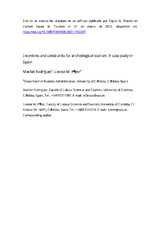Incentives and constraints for archeological tourism: a case study in Spain

Autor
Rodríguez, Maribel
Pérez Naranjo, Leonor
Editor
Taylor & FrancisFecha
2020Materia
Dual factor theoryPull factor
Constraint
Behavioral intention
Archeological tourism
METS:
Mostrar el registro METSPREMIS:
Mostrar el registro PREMISMetadatos
Mostrar el registro completo del ítemResumen
Archeological tourism has great potential for development in numerous destinations. However, literature on archeotourism is scarce and empirical data are very limited. This paper analyzes the incentives to participate in archeotourism and, following the Dual Factor Theory, examines how incentives and constraints may affect the intention to participate in archeotourism in Spain. Data were collected from 521 domestic tourists. An exploratory factor análisis revealed 6 dimensions of incentives: core archeological attraction, aspects that favour the acquisition of historic-cultural knowledge, archeotourism development of the destination, participatory archeological activities, extra archeological attraction and leisure activities. A multiple regression analysis showed that, except leisure activities, alldimensions are crucial incentives for behavioral intention. However, for the oldest age groups, in addition to leisure activities, participatory archeological activities and extra archeological attractions are also not key incentives. On the other hand, among the constraints analyzed, only intrapersonal barriers significantly affect tourists’ intentions.
